Many of my pieces are landscapes. I feel very comfortable out of doors, I've always camped, hiked, and fished. I strive to communicate to others, through my artwork, the amazement I feel for Nature's wonders. I work to improve my skills so that I may share the sunsets, the shadows on the path, or the flowers in the fields.
Part of my education is through reading. These are books of landscape art and painting techniques.
Carlson's Guide to Landscape Painting, John F. Carlson
Landscape Illusion, Daniel Chard
Landscape Problems and Solutions, Trudy Friend
Painting the Landscape in Pastel, Albert Handell and Anita Louise West
Painting Better Landscapes, Margaret Kessler
Landscape: a Comprehensive Guide to Drawing and Painting Nature, Richard McDaniel
Paint the Changing Seasons in Pastel, Elizabeth Mowry
Painter's Quick Reference, Landscapes, North Light Books
Different Views in Hudson River School Painting, Judith Hanson O'Toole
Painting Landscapes in Pastel, Ernest Savage
Painting the Effects of Weather, Patricia Seligman
Oil Painter's Solution Book: Landscapes,Elizabeth Tolley
The Hudson River School: American Landscape Artists, Bert D. Yaeger
"Climb the mountains and get their good tidings. Nature's peace will flow into you as sunshine flows into trees. The winds will blow their own freshness into you, and the storms their energy, while cares will drop off like autumn leaves." ~John Muir
Saturday, January 31, 2009
Water Lilies

"Water Lilies", 2008
Prismacolor colored pencil on paper, 5 1/4" x 9"
Prismacolor colored pencil on paper, 5 1/4" x 9"
This drawing was made from a reference photograph taken by my daughter in the Chicago Botanic Garden. The dark water is many layers of color, black was not used.
Prismacolor colored pencils are wax-based and are susceptible to wax bloom, especially dark colors. The wax rises to the surface and creates a gray haze. It can appear on the drawing surface after a week. The haze can be wiped off with a facial tissue or cotton ball, but be sure not to remove pigment or smear the piece by using too much pressure. Wax bloom can be prevented by spraying the finished piece with fixative. I use several light coats of Workable Fixative.
Prismacolor colored pencils are wax-based and are susceptible to wax bloom, especially dark colors. The wax rises to the surface and creates a gray haze. It can appear on the drawing surface after a week. The haze can be wiped off with a facial tissue or cotton ball, but be sure not to remove pigment or smear the piece by using too much pressure. Wax bloom can be prevented by spraying the finished piece with fixative. I use several light coats of Workable Fixative.
Sunlit Branches

"Sunlit Branches", 2008
Prismacolor colored pencil on paper, 9 1/2" x 7"
Prismacolor colored pencil on paper, 9 1/2" x 7"
This colored pencil work was developed from my reference photograph of this old tree. It was taken in the afternoon with the sun shining on the branches. The tree is in the Mass Audubon's Welfleet Bay Wildlife Sanctuary in Welfleet, MA. This 1,100 acre preserve has salt marsh, beach, woodlands, a fresh water pond, and a heathland. It is a wonderful source of inspiration for paintings and drawings.
"Sunlit Branches" was begun with a very light graphite drawing of the tree. After completing such initial drawings, I often lighten the lines with a kneaded eraser until they can barely be seen. A graphite drawing will show through colored pencil. Then I begin with my lightest color and continue to add layer upon layer of ever darkening colors. Keeping the pencil point very sharp enables you to have more complete color coverage by getting the pencil color into the tooth of the paper. If your pencil point is rounded, the point will hit the high parts of the paper leaving white dots in your color. I use a tiny circular stroke to apply the pencil.
"Sunlit Branches" was begun with a very light graphite drawing of the tree. After completing such initial drawings, I often lighten the lines with a kneaded eraser until they can barely be seen. A graphite drawing will show through colored pencil. Then I begin with my lightest color and continue to add layer upon layer of ever darkening colors. Keeping the pencil point very sharp enables you to have more complete color coverage by getting the pencil color into the tooth of the paper. If your pencil point is rounded, the point will hit the high parts of the paper leaving white dots in your color. I use a tiny circular stroke to apply the pencil.
Foxes
Underpainting

"Chrysanthemums", 2007
pastel on Wallis paper, 18" x 12"
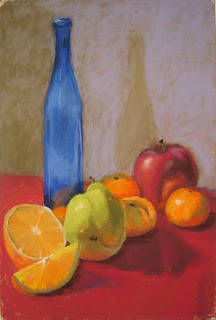
"Blue Bottle", 2007
pastel on sanded Wallis paper, 18" x 12"
These paintings were done in a workshop with Rosalie Nadeau, PSA, at the Creative Arts Center in Chatham, MA. Each painting has an underpainting of a few warm colors in large value shapes. Matching the values was important. For dark values I chose a dark, warm pastel. When the entire picture was blocked in, the warm color was rubbed into the Wallis paper. I then used "real" colors for the composition over the underpainting. This adds color interest, and helps the artist move away from photographic color. Each painting was completed in one session.pastel on sanded Wallis paper, 18" x 12"
This workshop certainly pushed me to work out of my comfort zone. Rosalie, as have other teachers, encouraged me to work "looser". My pastels and especially my colored pencil drawings are "tight". Since this class I've read an article by Gary Greene in the November 2008 issue of the Artist's Magazine. The title was "Uptight is All Right!". I guess there's room for every style.
Friday, January 30, 2009
Indian Corn
Thursday, January 29, 2009
2007 Exhibit
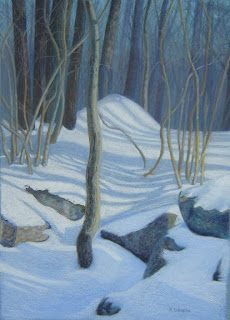
"Mill Wood", 2007
pastel on Strathmore paper, 13 1/2" x 9 1/2"
"Mill Wood" is the site of the Lovellville Mill in Holden, MA. In the spring of 1916, the mill burned in a fire started by a spark from a locomotive.
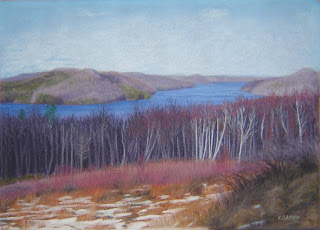
"Enfield Lookout", 2007
pastel on Strathmore paper, 10" x 14"
pastel on Strathmore paper, 10" x 14"
Enfield Lookout is in Ware, MA. From this place you can see the Prescott peninsula and the waters of the Quabbin that now cover most of the former town of Enfield. The Swift River Valley was flooded in the 1930s to create the Quabbin Reservoir water supply for Boston. The lookout is a great place to spot bald eagles.
These pastels were part of the 2007 Four Seasons of Wachusett Greenways Art and Photography Exhibit that traveled three towns over a period of months. All pieces were to pertain to the trails, greenways, and open spaces of the Wachusett region. Both pieces were done in the studio from my reference photos.
These pastels were part of the 2007 Four Seasons of Wachusett Greenways Art and Photography Exhibit that traveled three towns over a period of months. All pieces were to pertain to the trails, greenways, and open spaces of the Wachusett region. Both pieces were done in the studio from my reference photos.
Wednesday, January 28, 2009
Lighthouse
Tuesday, January 27, 2009
Watercolor and Colored Pencil

"Reflection", 2007
Watercolor, tissue paper, Prismacolor pencil on watercolor paper, 9" x 11 3/4"
In a demonstration lesson in Janie Gildow's Colored Pencil Explorations, artist Allan Servoss arranged pieces of rice paper on an unwanted painting to create a new surface for water color and pencil. This is my interpretaion of that lesson.
The photo reference was a picture I took in the fall along a favorite hiking trail. The sun was setting and the overhead trees were reflected in the water beside the path. Using gesso, I adhered torn tissue paper to a piece of Strathmore 130 lb. watercolor paper. Using a limited palette I did a very loose water color painting then added detail and shape to the leaves and branches with Prismacolor pencils. The resulting work was looser and more abstract than my other pieces.
The photo reference was a picture I took in the fall along a favorite hiking trail. The sun was setting and the overhead trees were reflected in the water beside the path. Using gesso, I adhered torn tissue paper to a piece of Strathmore 130 lb. watercolor paper. Using a limited palette I did a very loose water color painting then added detail and shape to the leaves and branches with Prismacolor pencils. The resulting work was looser and more abstract than my other pieces.
Reading
When I become interested in a technique or media I search out as much reading material as I can. I subscribe to "Pastel Journal" and "American Artist", and I use my library constantly. Books that are suggested in blogs, on websites, in articles, or by friends I search out in interlibrary loan. I often look the book up first on Amazon and check it out with the "search inside this book" feature to see if it will be of interest and I can learn something new. Then I order it from the library. If I really enjoy the book or feel that I need a copy on hand as a reference, I often buy it in used condition on Amazon. I have never been disappointed by the condition of a book when bought in good used condition. Plus, the price is great!
Some colored pencil books I've read:
Painting Light with Colored Pencil, Cecile Baird
Basic Colored Pencil Techniques, Bet Borgeson
Colored Pencil for the Serious Beginner, Bet Borgeson
Colored Drawing Workshop, Bet Borgeson
Realistic Pet Portraits in Colored Pencil, Anne deMille Flood
Colored Pencil Explorations, Janie Gildow
Colored Pencil Solution Book, Janie Gildow and Barbara Newton
Creating Texture in Colored Pencil, Gary Greene
Creating Radiant Flowers in Colored Pencil, Gary Greene
Creative Colored Pencil Workshop, Carlynne Hershberger
The Complete Guide to Colored Pencil Techniques, Beverly Johnson
Drawing and Painting with Colored Pencil, Kristy Ann Kutch
Colored Pencil Portraits, Step by Step, Ann Kullberg
The Encyclopedia of Colored Pencil Techniques, Judy Martin
The Complete Colored Pencil Book, Bernard Poulin
Masterful Color: Vibrant Colored Pencil Paintings, Layer by Layer, Arlene Steinberg
Colored Pencil for All, Michael Warr
I'm always looking for more....
Some colored pencil books I've read:
Painting Light with Colored Pencil, Cecile Baird
Basic Colored Pencil Techniques, Bet Borgeson
Colored Pencil for the Serious Beginner, Bet Borgeson
Colored Drawing Workshop, Bet Borgeson
Realistic Pet Portraits in Colored Pencil, Anne deMille Flood
Colored Pencil Explorations, Janie Gildow
Colored Pencil Solution Book, Janie Gildow and Barbara Newton
Creating Texture in Colored Pencil, Gary Greene
Creating Radiant Flowers in Colored Pencil, Gary Greene
Creative Colored Pencil Workshop, Carlynne Hershberger
The Complete Guide to Colored Pencil Techniques, Beverly Johnson
Drawing and Painting with Colored Pencil, Kristy Ann Kutch
Colored Pencil Portraits, Step by Step, Ann Kullberg
The Encyclopedia of Colored Pencil Techniques, Judy Martin
The Complete Colored Pencil Book, Bernard Poulin
Masterful Color: Vibrant Colored Pencil Paintings, Layer by Layer, Arlene Steinberg
Colored Pencil for All, Michael Warr
I'm always looking for more....
Poppy and Mock Orange

"Poppy", 2007
Prismacolor pencil on Strathmore paper, 9 3/4" x 7"
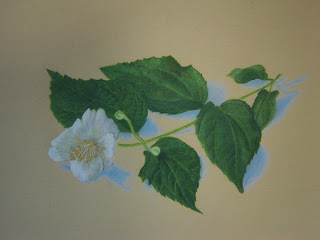
"Mock Orange", 2007
Prismacolor pencil on Strathmore paper, 7" x 11"
I continued to work with colored pencil. "Mock Orange" was drawn with blooms from the yard placed on my drawing board. The leaves were done with the impressed line technique to form the veins. Impressed line can work in a number of ways, for example, keeping a white paper for a cat's whiskers. Lighter colors cannot be added over dark with pencil, but if a light is forgotten, it can be added at the end with gouache.
"Poppy" was drawn from two photos. I used parts of each picture and simplified the background. The background was completed with many layers of colored pencil. The stems in this picture have not been completed.
Monday, January 26, 2009
Colored Pencil
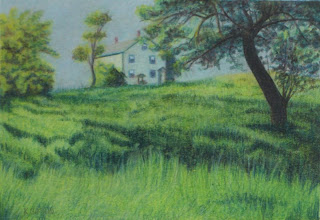 "Princeton Farm",2007
"Princeton Farm",2007Prismacolor colored pencil on Bristol paper, 4" x 5 3/4"
I developed an interest in colored pencil. After seeing pieces by Jamie Gildow, Gary Greene, David Dooley, and Barbara Edidin, I said what everyone says, "That's colored pencil?" It seemed like the perfect media, lots of color, no mess, and when you stop, you just put down the pencil. When I have a few minutes, I can slip away and work on a drawing.
"Princeton Farm" was my first attempt and I filled the tooth of the paper too quickly by using too much pencil pressure. Now I start with light pressure and a very sharp pencil point. Many layers of pencil color develop more exciting blends and colors with depth.
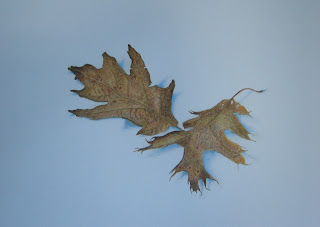
"Oak Leaves", 2007
Prismacolor pencil on Bristol paper, 9" x 11"
This next drawing is more successful. I drew two oak leaves gathered from the yard and placed on my drawing board. I used Prismacolor colored pencils (which are wax-based) with a gentle pressure and small, circular strokes. I created the veins using an impressed line that stayed light as I added further layers.
Impressed lines can be made using a piece of tracing paper or vellum and a pencil or ballpoint pen. Place the tracing paper over the drawing and draw the veins pressing down with the pen on the tracing paper. This creates the indentation in your drawing surface.
Sunday, January 25, 2009
Rachel

"Rachel", 2007
pastel on Wallis paper, 10" x 14"
pastel on Wallis paper, 10" x 14"
This was the first serious portrait. Not a conventional portrait in the sense of a sitting in the studio. This painting was done from my photograph, but I know Rachel well. She is standing on the beach after a day in the surf and sun. Photos can dull the lights in a scene and darken the details in the shadows, but I wanted to capture the naturalness and emotion of her expression. I wanted to catch the wisp of hair across her face, and I loved her hat.
I first used pastel pencil to sketch Rachel, then followed with stick pastels. I might use a pencil for small detail, too, but pencil lacks the vibrant color of sticks. I used the Wallis paper to hold the layers of pastel, but I missed the smoothness of Mi-teintes for obtaining realistic effects. I struggle even now to control blending and the desire for smoothness. Using sanded paper helps to discourage excessive blending with my fingers. I learned the hard way- until the tips of my fingers were worn.
This pastel is in a private collection.
I first used pastel pencil to sketch Rachel, then followed with stick pastels. I might use a pencil for small detail, too, but pencil lacks the vibrant color of sticks. I used the Wallis paper to hold the layers of pastel, but I missed the smoothness of Mi-teintes for obtaining realistic effects. I struggle even now to control blending and the desire for smoothness. Using sanded paper helps to discourage excessive blending with my fingers. I learned the hard way- until the tips of my fingers were worn.
This pastel is in a private collection.
Beech
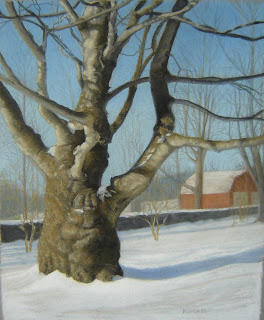
"Beech", 2007
pastel on paper, 12 1/2" x 10 1/4"
This tree is near our town center. I enjoyed doing the painting, but I fell short of my goal. The image lacks a feeling of weight and mass. I will paint it again.pastel on paper, 12 1/2" x 10 1/4"
This tree is magnificent with smooth bark, folds, and massive reaching limbs. The next approach needs a change in composition and a new perspective, maybe looking up into the tree, with greater focus on the negative spaces between the branches. A more abstract composition might better suit the subject. It needs more emphasis on the shape of the trunks and limbs or more variety of color. Or... maybe, no color. A charcoal drawing that would focus on the texture of the bark .
This beech has a strength, history, and a character of its own that I will approach more as a portrait.
Pelicans and Rock Harbor
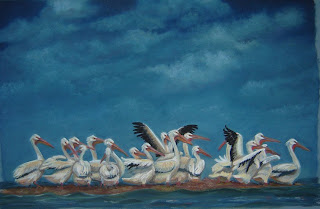
"Pelicans", 2007
pastel on Strathmore paper, 12" x 19"
This painting was done from a photo that was not mine, but the pelicans were so animated and almost cartoon-like that I wanted to paint them. It was fun to do.pastel on Strathmore paper, 12" x 19"
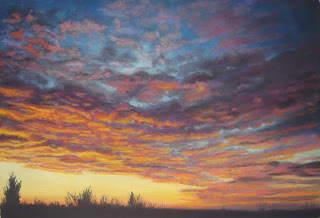
"Rock Harbor Sunset", 2007
pastel on Wallis paper, 12" x 17"
pastel on Wallis paper, 12" x 17"
I often take reference photographs as a means to capture a moment. Light changes quickly, birds and insects fly away, and children move. The color of the sky on this evening on the shore continued to intensify after the sun went down.
This was my first pastel on Kitty Wallis paper, and it was challenging. The sanded surface holds a lot of pigment.
This was my first pastel on Kitty Wallis paper, and it was challenging. The sanded surface holds a lot of pigment.
Saturday, January 24, 2009
The Beginning
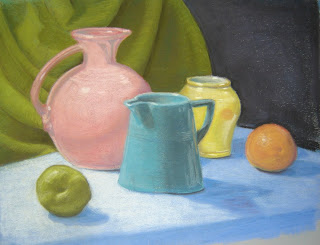
"Pitchers", pastel on Strathmore paper
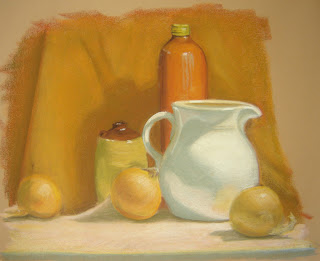
"Still Life with Onions", pastel on Strathmore paper
I've drawn and painted since I was a child. The desire to create has always been there. Now I've been able to make art a greater part of my life. Two years ago I studied with Ella Delyanis, pastelist and painter. These still lifes were drawn from her setups using Nupastel and Rembrandt pastels on Strathmore charcoal paper. Since this beginning I've added Sennelier and Unison pastels and Wallis sanded paper and Canson Mi-teintes pastel paper to my stock. The smooth side of Mi-teintes paper is my surface of choice, but I am careful not to fill the paper's tooth too quickly. I begin with the harder pastels and finish with the soft buttery sticks.
Subscribe to:
Posts (Atom)



